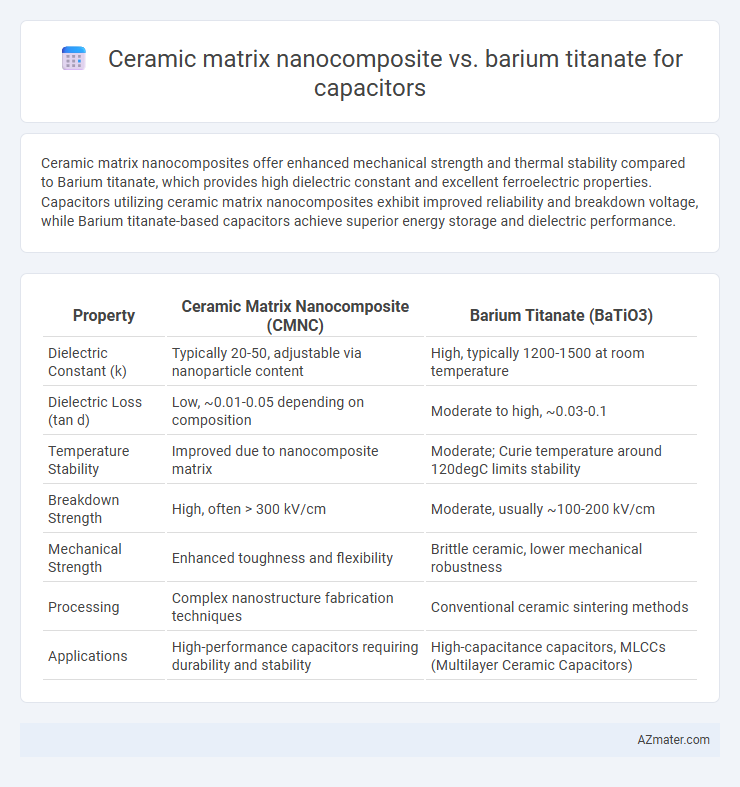Ceramic matrix nanocomposites offer enhanced mechanical strength and thermal stability compared to Barium titanate, which provides high dielectric constant and excellent ferroelectric properties. Capacitors utilizing ceramic matrix nanocomposites exhibit improved reliability and breakdown voltage, while Barium titanate-based capacitors achieve superior energy storage and dielectric performance.
Table of Comparison
| Property | Ceramic Matrix Nanocomposite (CMNC) | Barium Titanate (BaTiO3) |
|---|---|---|
| Dielectric Constant (k) | Typically 20-50, adjustable via nanoparticle content | High, typically 1200-1500 at room temperature |
| Dielectric Loss (tan d) | Low, ~0.01-0.05 depending on composition | Moderate to high, ~0.03-0.1 |
| Temperature Stability | Improved due to nanocomposite matrix | Moderate; Curie temperature around 120degC limits stability |
| Breakdown Strength | High, often > 300 kV/cm | Moderate, usually ~100-200 kV/cm |
| Mechanical Strength | Enhanced toughness and flexibility | Brittle ceramic, lower mechanical robustness |
| Processing | Complex nanostructure fabrication techniques | Conventional ceramic sintering methods |
| Applications | High-performance capacitors requiring durability and stability | High-capacitance capacitors, MLCCs (Multilayer Ceramic Capacitors) |
Introduction to Advanced Capacitor Materials
Ceramic matrix nanocomposites exhibit enhanced dielectric properties and mechanical strength, making them ideal for high-performance capacitors. Barium titanate, a well-known ferroelectric ceramic, offers high permittivity and stable temperature characteristics crucial for capacitor efficiency. Comparing these materials highlights advancements in capacitor design, optimizing energy storage and reliability in electronic devices.
Overview of Ceramic Matrix Nanocomposites
Ceramic matrix nanocomposites (CMNCs) exhibit enhanced dielectric properties and mechanical strength compared to traditional materials like barium titanate, making them ideal for advanced capacitor applications. These composites integrate nanoscale ceramic fillers within a ceramic matrix, improving permittivity, thermal stability, and breakdown voltage. Their tailored microstructure enables superior energy storage density and reliability in high-performance capacitors.
Fundamentals of Barium Titanate in Capacitors
Barium titanate (BaTiO3) is a ferroelectric ceramic material widely used in capacitors due to its high dielectric constant and excellent temperature stability, enabling efficient energy storage and dielectric performance. Compared to ceramic matrix nanocomposites, BaTiO3 offers superior dielectric properties derived from its perovskite crystal structure, which enhances polarization under electric fields. This fundamental characteristic makes barium titanate a preferred dielectric material in multilayer ceramic capacitors (MLCCs) for electronic devices requiring miniaturized, high-capacitance components.
Dielectric Properties Comparison
Ceramic matrix nanocomposites exhibit enhanced dielectric constant and breakdown strength due to the uniform dispersion of nanoparticles, resulting in higher energy storage density compared to pure Barium titanate. Barium titanate, a well-known ferroelectric ceramic, provides high permittivity but often suffers from higher dielectric loss and lower thermal stability. The integration of nanocomposite structures improves dielectric performance by minimizing defects and optimizing interfacial polarization in capacitors.
Microstructure and Material Performance
Ceramic matrix nanocomposites exhibit enhanced dielectric properties and mechanical strength due to their finely dispersed nanoscale fillers within the ceramic matrix, offering improved microstructural uniformity and reduced grain boundary defects compared to traditional materials. Barium titanate (BaTiO3), a widely used ferroelectric ceramic, provides high permittivity and polarization, but its performance is often limited by grain size and ceramic sintering conditions that influence domain structure and stability. The integration of nanocomposites enhances breakdown voltage, dielectric constant, and thermal stability, outperforming pure barium titanate ceramics in capacitor applications.
Energy Storage Capabilities
Ceramic matrix nanocomposites exhibit superior energy storage capabilities due to their high dielectric strength and enhanced mechanical stability, allowing for greater charge density and reliability under high electric fields compared to pure ceramics. Barium titanate, known for its high dielectric constant, provides excellent energy storage efficiency but often suffers from lower breakdown strength and reduced thermal stability. The integration of nanoparticles within ceramic matrices can significantly improve energy density and reduce losses, making ceramic matrix nanocomposites more advantageous for advanced capacitor applications requiring both high energy storage and endurance.
Thermal Stability and Reliability
Ceramic matrix nanocomposites exhibit superior thermal stability compared to barium titanate, maintaining consistent dielectric properties at elevated temperatures above 200degC. The enhanced grain boundary strength and reduced thermal expansion mismatch in ceramic matrix nanocomposites improve capacitor reliability under thermal cycling conditions. In contrast, barium titanate capacitors often face performance degradation due to phase transitions and increased leakage currents at high temperatures.
Fabrication Techniques and Scalability
Ceramic matrix nanocomposites for capacitors are typically fabricated using sol-gel processing, spark plasma sintering, or chemical vapor infiltration, enabling fine control over nanoparticle dispersion and enhanced dielectric properties. Barium titanate capacitors are commonly produced through solid-state reaction or hydrothermal synthesis, methods well-established for large-scale industrial manufacturing and high-volume production. Scalability of ceramic matrix nanocomposites remains challenging due to complex processing steps, whereas barium titanate offers greater scalability and cost-effectiveness in mass production.
Cost-Effectiveness and Commercial Viability
Ceramic matrix nanocomposites offer enhanced dielectric properties and mechanical strength, often resulting in improved energy density and reliability for capacitors compared to barium titanate. Barium titanate remains a cost-effective, widely used dielectric material due to its established manufacturing processes and availability, making it commercially viable for standard capacitor applications. However, the higher production costs of ceramic matrix nanocomposites currently limit their mass-market adoption despite superior performance benefits in specialized capacitor designs.
Future Trends in Capacitor Material Development
Ceramic matrix nanocomposites exhibit superior dielectric properties and enhanced mechanical strength compared to traditional Barium titanate, making them promising candidates for next-generation capacitors. Advances in nanoscale engineering enable precise tuning of electrical characteristics, promoting higher energy densities and improved thermal stability. Future trends emphasize integrating these nanocomposites to achieve miniaturization, increased efficiency, and reliability in capacitors for advanced electronics and energy storage systems.

Infographic: Ceramic matrix nanocomposite vs Barium titanate for Capacitor
 azmater.com
azmater.com